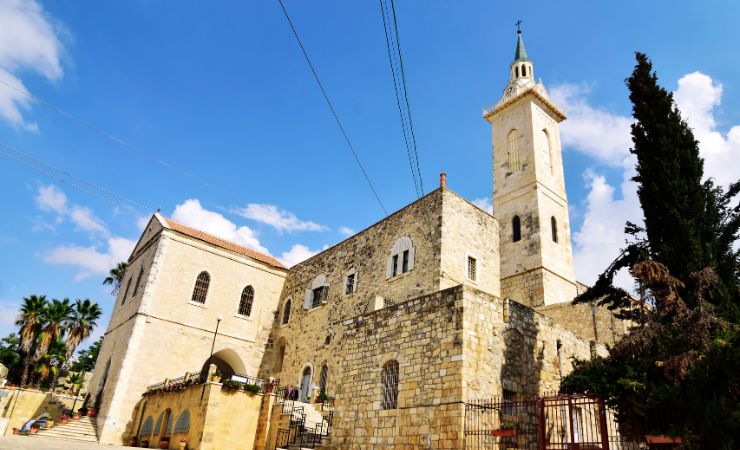The Church of St. John Ba Harim: Ein Karem's Jewel

Location
St. John Ba Harim is located in the heart of Ein Karem, a quaint village in Jerusalem.
Biblical context
The Bible introduces us to John the Baptist as a pivotal figure in the New Testament. Born to Zechariah and Elizabeth, John’s birth was nothing short of miraculous. Elizabeth, who was barren and advanced in age, was blessed with John after an angelic prophecy.
John’s role was to prepare the way for Jesus, and he did so by preaching about repentance and baptizing those who believed in the coming Messiah.
John Ben Harim Church is build on top of the cave which, according to tradition, was the birth place of John the Baptist.



The History of St. John Ba Harim
Ein Karem has a history that stretches back over 6,000 years, with its earliest settlements dating back to the Neolithic period. By the first century, it was inhabited by Jews, but it wasn’t until the 6th century CE that Christian pilgrims began associating Ein Karem with John the Baptist. The earliest testimony of this association comes from Theodosius, who traveled the Holy Land in the 530s and wrote about the location of Saint Elizabeth’s home, the mother of John the Baptist.
The Church of St. John Ba Harim, affiliated with the Franciscan order, has undergone various architectural phases. Most of the current church structure likely dates back to the 11th century, with some parts possibly from the Byzantine period (4th-7th century). The church’s history reveals a blend of Roman, Byzantine, and Early Muslim influences.
In the 17th century, the site of the Crusader church, built above the traditional birth cave of St. John, was purchased by Franciscan custos, Father Thomas of Novara. Despite challenges, including forced abandonments and the site being used as stables, the Franciscans eventually fortified and rebuilt the site in the late 17th century.
By the end of the 19th century, the church had undergone significant restorations. The main restorations were done between 1857 and 1900, with support from the Royal family of Spain. The royal family of Spain continues to support the church to this day.
During the Second World War, a British artillery unit camped near the church inadvertently caused damage, leading to excavations by the Franciscans. These excavations in the 1940s revealed graves, rock-cut chambers, wine presses, and small chapels with mosaic tiling. Notably, a Jewish ritual bath (Miqveh) was discovered, suggesting Jewish priests might have resided here during the First Century, aligning with the biblical account of Zechariah, John’s father, being a priest.
Inside the Church of St. John Ba Harim
Upon entering the Church of St. John Ba Harim, you will be immediately struck by the blend of historical significance and artistic beauty. As mentioned, the main funding for rebuilding and renovating the church at the second half of the 19th century was provided by the Spanish royal family.
This Spanish influence is evident in the church’s interior, from the blue glazed tiles and artwork made by Spanish artists to the Spanish royal coat-of-arms.
Benedictus Tablets: In the church courtyard, you will find stone tablets inscribed with the words of the Prayer known as the Benedictus (Latin for “blessed”), translated into 31 languages. This prayer was recited by Zechariah in gratitude for the birth of his son.
The Grotto of Birth: One of the most significant features inside the church is a cave believed to be the birthplace of John the Baptist. This grotto, located at the front of the left aisle, has been a focal point for pilgrims and visitors for centuries. The exact spot where John was born is marked by a marble star beneath an unadorned altar. Above the entrance to the grotto, the arch bears the opening line of Zacharias’ prayer of Thanksgiving – “Benedictus Dominus Deus Israel”. The painting above the opening depicts John baptizing Jesus, with the Holy Spirit looking over them in the form of a dove.
Mosaic Pavement: The church boasts a beautiful mosaic pavement under its central cupola.
Artistic Representations: Above the main altar dedicated to Saint John the Baptist, there’s a representation of Mary wearing a blue cloak. To her left stands a statue of Zacharias dressed in priestly robes, and to her right, a sculpture of Elizabeth.
Painting by El Greco: To the right of the main apse, a painting attributed to El Greco, a renowned Greek-born Spanish painter, hangs behind an ornate, wrought iron door. The painting envisions Elizabeth’s meeting with Mary, with Zechariah watching over Elizabeth’s shoulder.
Nearby Sites
Mary’s Well: A significant site believed to be where Mary drank water during her visit to Elizabeth.
Church of the Visitation: Located a short distance from St. John Ba Harim, this church commemorates Mary’s visit to Elizabeth.
- Abu Gosh Crusader Church: Also known as the Church of St. Mary of the Resurrection, this church in Abu Gosh dates back to the Crusader period and is renowned for its well-preserved frescoes.
- Abu Gosh Benedictine Monastery: This monastery is dedicated to the Ark of the Covenant, believed by some to have been housed in Abu Gosh for a time.



